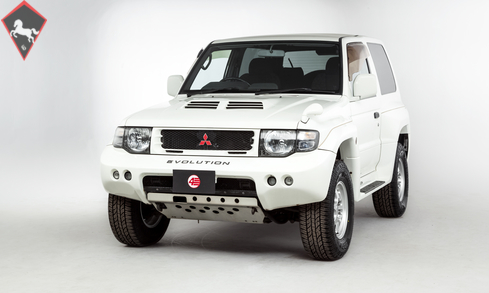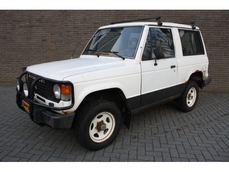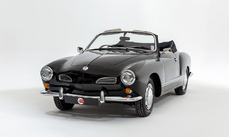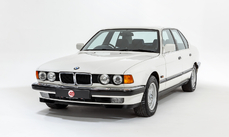Mitsubishi Other Evolution 1997
Allgemeine Beschreibung :
Model History
The Mitsubishi Pajero, known as the Shogun in the UK, is a Sport Utility Vehicle that first launched in 1982. With roots tracing back to the 1934 PX33 prototype, the first generation of Pajero was unveiled at the Tokyo Motor Show in 1981; the fourth generation is still in production today. Modified versions of the Pajero are noted for having won the Dakar Rally 15 times.
A redesigned second generation Pajero debuted in January 1991. Just about everything was new and further enhanced. It also saw the introduction of Super Select 4WD (SS4), multimode ABS, and electronic shock absorbers. SS4 was groundbreaking in the sense that it combined the advantages of part-time and full-time four-wheel drive with four available options: 2H (high-range rear-wheel drive), 4H (high-range full-time four-wheel drive), 4HLc (high-range four-wheel drive with locked centre differential) and 4LLc (low-range four-wheel drive with locked centre differential). Another advantage of this second generation system is that it gave the driver the ability to switch between two-wheel drive and full-time four-wheel drive at speeds up to 62 mph. Multimode ABS was equally innovative. This meant that the ABS would be fully functional in all modes of SS4, as braking with a locked centre differential requires completely different braking parameters.
The Pajero Evolution was introduced in October 1997 and was developed in response to new entry requirements for the Dakar Rally's T2 Class. The Evolution came standard with a 3.5-litre 24-valve DOHC V6 that featured Mitsubishi Innovative Valve Timing and Electronic Lift Control system (MIVEC). A new dual plenum variable intake helped increase power, and a new independent rear suspension made the ride even smoother. A grand total of 2,500 were manufactured for homologation purposes. They could be ordered in either Sofia White, Passion Red, or metallic Satellite Silver.
Mitsubishi not only dominated the T2 class with this car, they dominated the whole Dakar Rally. Paj-Evos took the top three spots in 1998, beating even the supposedly faster T3 class cars. They covered over 10,000km in 18 days, and finished five hours before the next competitor. Pajeros have won nearly half of all the Dakar Rallies with 15 wins overall.
Equipment
Sofia White paintwork, Recaro cloth upholstery, INVECS-II five-speed automatic transmission with Sports mode, Super Select 4WD system, Rear spoiler delete, Aluminium skid plate, Four-wheel independent suspension (ARMIE), Privacy glass, Automatic air conditioning, Leather-trimmed steering wheel, Carbon-effect trim, Electrically adjustable door mirrors, Colour-coded door mirror casings, Passenger side wing mirror, ABS, Wind deflectors, Front SRS airbags, Spare wheel, Toolkit.
Exterior
Finished in rare Sofia White, this low mileage Evolution appears in wonderful condition and boasts an excellent rust-free underside. The gleaming bodywork shows few imperfections with just a couple of minor blemishes on the tailgate to report. There is no damage to the rugged bumpers or wheel arches, with no unsightly car park dings on the doors either. What makes this particular Paj-Evo so unique is the lack of a rear spoiler and side airdams; we understand the car to have been spec’d without them.
Interior
The Evolution boasts Recaro front sports seats upholstered in a special patterned cloth. Carbon-effect inlays adorn the console and dash clusters while the remaining trim is in a more subdued grey. The cabin maintains a purposeful aesthetic with centrally mounted gauges and a digital compass, a leather-trimmed sports steering wheel, and drilled aluminium pedals. The seats are without any damage to the bolsters and the carpets are still protected in the footwells by original Pajero overmats.
ENGINE & TRANSMISSION
Free from any rust, damage or signs of poor repair the engine bay appears in excellent order throughout. The Evolution’s 3.5-litre V6 uses the MIVEC system to vary the timing of the intake and exhaust camshafts to increase the power and torque output over a broad engine speed range. The DOHC 24V powerplant produces 276hp at 6,500rpm and 257 ft-lb at 3,500rpm.
This 54k mile example has just been given a clean bill of health following on from some mechanical work we have recently had done. All six injectors were replaced with genuine Mitsubishi parts at a cost of over £1,800, and the engine has also been serviced with new spark plugs. The car drives really well and is complete with an MOT valid until February 2020.
WHEELS, TYRES & BRAKES
The original six-spoke alloys (including the spare) have been freshly refurbished to the highest standard by Lepsons; they look amazing and really set the Evo of nicely. Better still, all five tyres have just been replaced with a brand new set of rugged Yokohamas. The old tyres were the only advisory item noted on the recent Inspection Report and so now the car presents in excellent fettle all round. Out on the road the brakes perform well and also look great following a cosmetic refresh of the calipers.
History File
The Pajero was first registered in November 1997. As one of only 2,500 Evolutions ever produced it's a rare beast indeed. Supplied new to Japan it was imported into the UK by 4 Star last year and has since undergone some light mechanical preparation prior to being advertised. It is now fully registered and offered for sale for the first time in the UK, freshly serviced and MOT'd until February 2020.
http://www.4starclassics.com/for-sale/mitsubishi-pajero-evolution-for-sale/
1997 Mitsubishi Other Evolution is listed verkauft on ClassicDigest in Kingsley by 4 Star Classics for £17995.
Fakten der Auto
Karosserietyp : Auto Marke : Mitsubishi Modell : Other Ausführung : Evolution Hubraum : 3.5 Modelljahr : 1997 Karosstyp : Pick up Lage : Hampshire
Verkauft
Angaben Zum Verkäufer
Verkauft
People who viewed this Mitsubishi Other also viewed similar Mitsubishi listed at ClassicDigest
Other cars listed for sale by this dealer
über Mitsubishi
Mitsubishi: Eine Reise durch die Geschichte (bis in die 1980er Jahre)1. Frühe Anfänge:
Gründung: Mitsubishis Wurzeln reichen zurück zur Gründung einer Schifffahrtsfirma durch Yataro Iwasaki im Jahr 1870.
Diversifizierung: Das Unternehmen expandierte in den Bergbau, den Schiffbau und andere Branchen, was die Grundlage für die Mitsubishi Group bildete.
2. Erste Automobilunternehmungen:
Erste Automobilproduktion: Mitsubishi wagte sich im frühen 20. Jahrhundert in die Automobilproduktion.
Modell-A: Im Jahr 1917 führte Mitsubishi sein erstes Serienfahrzeug, das Modell-A, ein, Japans erstes Serienautomobil.
3. Nachkriegsära:
Umstrukturierung: Nach dem Zweiten Weltkrieg stand Mitsubishi vor Herausforderungen, durchlief jedoch eine Umstrukturierung und nahm die Automobilproduktion wieder auf.
Produktion von Jeeps: Anfangs konzentrierte sich Mitsubishi auf die Produktion von Jeeps und trug erheblich zur Wiederbelebung der japanischen Automobilindustrie bei.
4. Meilenstein-Modelle:
Mitsubishi 500: 1960 eingeführt, war der Mitsubishi 500 ein Kompaktfahrzeug, das dazu beitrug, kleinere Fahrzeuge in Japan populär zu machen.
Mitsubishi Colt 600: 1962 herausgebracht, war der Colt 600 ein Kleinwagen, der dazu beitrug, Mitsubishis Präsenz auf dem Automobilmarkt zu stärken.
5. Globale Expansion und die 1970er Jahre:
Partnerschaften: Mitsubishi schloss Partnerschaften mit internationalen Automobilherstellern und erweiterte damit seinen Einfluss über Japan hinaus.
Galant und Lancer: Modelle wie der Galant und der Lancer gewannen in den 1970er Jahren an Popularität und zeigten Mitsubishis Engagement für Innovation und Leistung.
6. Technologische Fortschritte:
Mitsubishi Astron-Motor: In den 1970er Jahren eingeführt, wurde der Astron-Motor zum Markenzeichen von Mitsubishi-Fahrzeugen und war bekannt für seine Langlebigkeit und Effizienz.
7. Höhepunkt der 1980er Jahre:
Mitsubishi Pajero: Anfang der 1980er Jahre eingeführt, markierte der Pajero (Montero in einigen Märkten) Mitsubishis Einstieg in das SUV-Segment und wurde ein globaler Erfolg.
Starion: Der Starion, Mitte der 1980er Jahre eingeführt, war ein Sportwagen, der Mitsubishis Leistungsfähigkeit demonstrierte.
8. Klassische Modelle von Mitsubishi der 1980er Jahre:
Mitsubishi Delica: Der Delica, erstmals in den 1960er Jahren eingeführt, gewann in den 1980er Jahren an Popularität und war ein vielseitiger Van in verschiedenen Konfigurationen.
Mitsubishi Mighty Max: Dieser kompakte Pickup-Truck war bekannt für seine Robustheit und Praktikabilität.
Mitsubishi Mirage: Der Mirage, in Hatchback- und Limousinen-Versionen erhältlich, wurde aufgrund seiner Kraftstoffeffizienz und Zuverlässigkeit beliebt.
Mitsubishis Reise durch die 1980er Jahre spiegelt ihre Entwicklung von einem vielfältigen Konglomerat zu einem bedeutenden Akteur in der globalen Automobilindustrie wider. Das Jahrzehnt brachte die Einführung von ikonischen Modellen mit sich, die Mitsubishis Ruf für Innovation und Leistung stärkten.








